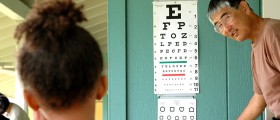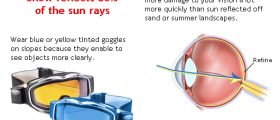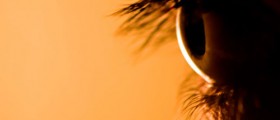
About Eye
Retina is to the eye what a sensor is to the digital camera or a film to the classical camera. It is located on the rear side of the eye, in what is basically a dark chamber. Light gets focused by the optical system on the eye and falls on the retina. It translates information from the light (color, intensity) to neural impulses and sends it through the optical nerve into the brain. In there, this information is deciphered, and the result of the deciphering process is vision. Entire photographic and TV technology is basically a copy of our own eye-brain system and function.
If things go wrong
Retina is attached to the supportive layer of tissue on the inner side of the eye, and can be peeled away from it in some cases. It all begins with a small tear in the retina, which can be caused by injury or trauma to the head or the eye or some medical conditions. The clear fluid that fills the eye and gives it its shape (it is a bit pressurized, feel how your eye keeps its shape if you gently press on it) can then seep between the retina and the supportive layer and make it peel off. Initial tear might be small but failure to treat it immediately will make the entire retina peel off, making the eye useless, blind.
What can be done?
As mentioned, retinal detachment requires immediate treatment. Luckily, the procedure that is most commonly is usually not complicated and you can undergo surgery and go home on the same day. What typically happens is that the doctor sews a specially designed peace of tissue-friendly rubber, silicone sponge or plastic (scleral buckle) to the white of the eye (on the outer side of it). This element pushes the white of the eye into the eye. This eases the pull on the retina and allows it to re-settle against the supporting layer. The scleral buckle is usually left in place permanently. It can cover only the immediate region of the detachment, or it may encircle the entire eyeball.
Extreme cold or heat or laser blast is used to scar the retina slightly and make it hold in place until it re-joins with the supportive layer. In some cases, the doctor might inject a gas bubble that will push the retina in place, or may have to suck out the liquid that got between retina and its supportive layer. This is done only if lots of liquid seeped in.
The ups and downs of surgery
As in every surgery, things can go wrong, but unwanted side effects are few and rare and well worth the risk regarding that you will loose vision unless you undergo surgery. In the days right after surgery, contact the doctor immediately and if you notice increasing pain, redness and swelling around the eye (some degree of this is normal, after all, the eye has been tampered with), or discharge from the eye, or if you have any kind of change of vision.
Most patients will not solve the problem with just one surgery.

















Your thoughts on this
Loading...